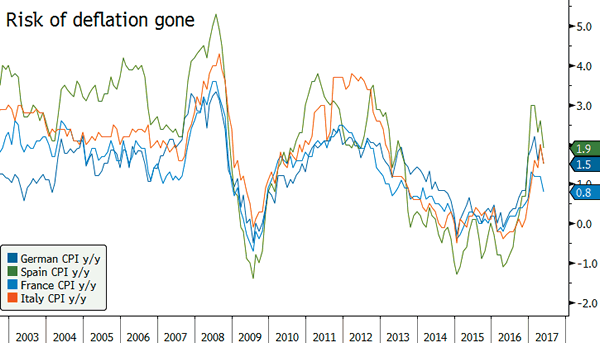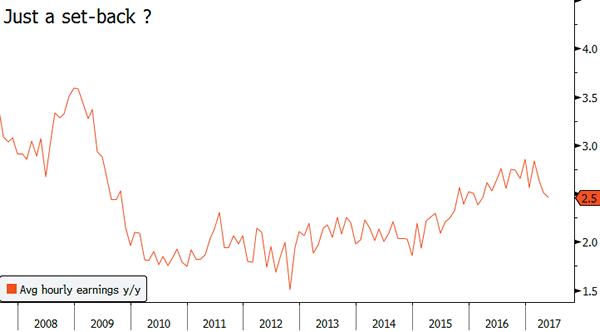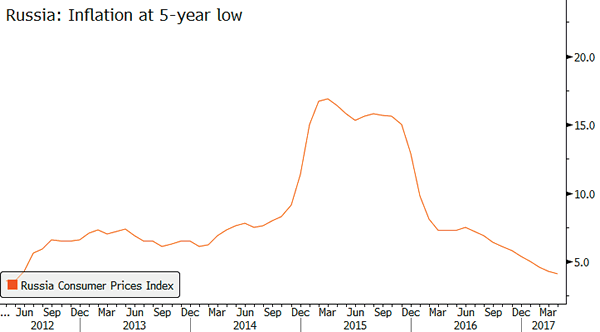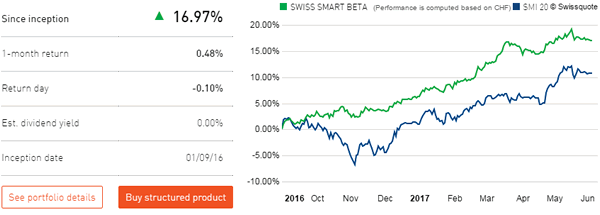- ECB’s Balancing Act – Peter Rosenstreich
- Weak Job Report Casts Shadow Over USD Outlook – Arnaud Masset
- Russia: More Room For More Easing – Yann Quelenn
- Swiss Smart Beta
Economics – ECB’s Balancing Act
In our annual outlook we highlighted three core themes that would drive asset prices in 2017. Trump pro-growth hype, global growth improvement and convergence of Fed and ECB policy (both heading toward "normalization"). This week the ECB could possibly shift slightly but meaningfully towards Fed / ECB convergence. We still anticipate the major adjustment will occur at the September meeting. Where the ECB will indicated the prospect of reducing emergency measure such as tapering bond purchase. However, there are growing risks that at the June meeting the ECB will setup the economic rationale for a change, usurping our call. ECB’s Draghi will attempt to keep all language dovish, in the hopes of keeping the Euro weak, but even the slightest signal will have Euro bulls changing.
At the April meeting ECB Council members agreed to reassess the monetary policy situation in June. Since that meeting, EU economic data has continued to show improvements (EU Composite PMI April rose to 56.4 from 56), supporting the central bank’s view that risks to growth has declined and were more balanced. There is also a marginal probability that the ECB will increase Eurozone growth annual forecast. Although a move of this type would make presenting any convincing dovish forward guidance problematic.
Recent comments and indication from the April Council is that no change in the easing bias was due to the failure of the surprising solid economy to generate sustainable inflation pressure. At the time uncertain inflation trends (transitory factors) provided a bit of credible support. However given the incoming data markets have become skeptical of this defense. While core inflation in May fell 0.9% from 1.2% (headline declined to 1.4% from 1.9%), deflation risk have nearly disappeared. Even should the ECB lower inflation forecast the rationale for extreme emergence measures are difficult to justify.
We suspect that removal of easing bias will not come from the official statement language. In fact we wouldn’t be surprised if there was a nod to additional expansionary measure possible. However, Draghi’s language at the press conference is likely to hold subtle signals. Taken in its entirety we expect the headlines after will indicates a minor shift from the ECB easing bias. There is a low probability that dovish bias has been adjusted by removing the possibly of lower interest rates or expansion of bond purchases. EURUSD has marginally priced in this outcome however we should get a retest of year high 1.1283 resistance. In the long run we expect the September meeting to include signaling the end of bond purchases in early 2018… and that will have profound effect on asset prices across the board.

Economics – Weak Job Report Casts Shadow Over USD Outlook
The last job report from the US dampened rate hike expectations by the Federal Reserve. In fact the report was rather mixed than disastrous as the unemployment rate fell to 4.3% the lowest level since May 2001, while the underemployment rate dropped 8.4% from 8.6% a month. However, one has to notice that the size of the active population shrunk in May and dragged the participation rate down to 62.7% from 62.9% a month ago. Therefore the improvement in the unemployment rate have to be taken with a grain of salt as it doesn’t reflect a strong job market.
Looking at the number of job created, the picture is not very bright either as the US economy added 138k nonfarm jobs, well below median forecast of 182k. In addition, April’s reading was downwardly revised to 174k, compared to 211k first estimate. All in all, it suggests that the Fed was incorrect by stating that it had "evidence" the Q1 weakness was transitory.
Finally, and this is in our opinion the most important point, wage growth is still not picking-up! Average hourly earnings grew 2.5%y/y in May and missed expectations of 2.6% but stabilised compared to last month. It may well prove to be the last straw that breaks the camel’s back and may force the Federal Reserve to slow down seriously its tightening pace as inflation is far from picking up.
In the FX market, the US dollar suffered a quick but limited sell-off as investors rushed into safe haven assets. The yellow metal rose 0.75% to $1,276 an ounce, the Japanese yen jumped 0.70% with USD/JPY sliding to 110.60, while the EUR/USD broke the 1.1268 (high from May 23rd) resistance to the upside and printed a new multi-month high at 1.1282. High yielding currencies were also in demand with the New Zealand dollar rising 1% to $0.7135, its highest level since March 2nd.
The limited market’s reaction suggests that market participants don’t know where to stand and are still reluctant to bet on further dollar weakness as many believe it is already oversold. It may be time to reconsider this statement as nothing supports a stronger dollar, neither from the fundamental side nor the political side as Trump’s economic reforms are stuck in limbo.

Economics – Russia: More Room For More Easing
In an effort to stabilize the ruble, Russia is looking to expand its Foreign- Exchange reserves (including Gold). Russia had disclosed this amount for the period ending 26 of May and has overcome expectations by $1 billion at $406.1 billion. Russia’s Central Bank has already made clear that one of its primary objectives is to increase those reserve holdings up to $500 billion as stated by Elvira Nabiullina, head of the central bank.
On top of that, Russian gold reserves could officially be above China gold reserves by year end.
Regarding the state of the Russian economy, concerns are still prevailing. Nabiullina said the economy has been resilient regarding international sanctions. As a result she hinted that interest rates may go even lower in the second half of this year. The key rate is currently standing at 9%.
Data-wise, inflation is collapsing, the last release printed at 4%. We recall that it was at an astonishing 16+% two years ago and the consumer prices growth is now standing at 4%.
The unemployment rate is also on its way down and is now reaching 5.2%. However, real disposable income should continue its decline in May after the strong decline in April of -7.6%.
Another matter of concern is the oil price as downside pressures are back and also despite the fact that OPEC has announced the extension of the cut for nine more months. The Russian economy minister said that the economy should resist to a barrel below $40. In our view the US shale gas industry is more and more competitive and we believe that oil prices should head back towards %.40.
For all those reasons, we reload our RUB short position against the dollar for some more time and we target 57 ruble for one dollar in the shortterm.

Themes Trading – Swiss Smart Beta
Swiss stocks have a reputation of being high quality and tend to provide stable returns during times of geopolitical uncertainty. With President Trump, Brexit, European elections and global protectionism, the world has become significantly more unpredictable. This portfolio sources highdividend Swiss stocks and provides an active quantitative overlay to optimize risk/reward potential. The Swiss Smart Beta theme consists exclusively of stocks from the Swiss Performance Index (SPI). The selection process identifies stocks with a high dividend yield and a market capitalization in excess of CHF 100 million. Illiquid stocks are screened for constant bid-ask spread and daily average dollar volume traded. To enhance risk diversification, the portfolio is weighted using an equally-weighted risk contribution approach. In summary, this means the allocation is calculated in such a way that each stock contributes on an equal basis to the total risk of the portfolio. This approach allows for low volatility and, in so doing, increases the risk/reward ratio.













